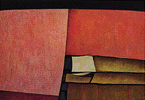In Cleveland, Bernard Pfriem, an art student, presented him his
first oil colors and advised him to leave the theater and dedicate himself to
painting. Gerzso answered, "You're mad! I'm not a painter!" But nonetheless, it
was then that he started painting. He found these first efforts clearly
unsuccessful.
His friend Juan O'Gorman, painter and architect, introduced him
to the group of Paris surrealist painters. Gerzso knocked at a door at number
4 Calle Gabino Barreda. Remedios Varo, the wife of Benjamin Pèret, opened
the door. She was living in quite a primitive state, Gerzso recalls, but
hanging on the walls were sketches by Picasso and Ernst. In the neighborhood
also lived Leonora Carrington. Edward James and Matta would visit them
when they were passing through, and they all exchanged visits Sundays in one
another's houses. Gerzso was asked to make a scene for a window-front
exhibition to aid the British war effort. Times were hard, and there was
little work. Gunther worked alone, painting canvases influenced by Picasso
and European surrealism, particularly that of Tanguy.
One day, he recounts,
he had the desire to create something that had to do with the Americas
alone. He found his style in a small painting, Tihuanacu, that was the father
of all of his later work. In 1951 lnés Amor offered to show his work in her
Galería de Arte Mexicano. "It was the biggest failure of the century," he
recalls. "No one went, no one bought."
His work since that time shows the
immense
impact of the Mexican landscape upon him. Gunther speaks openly of the
importance the forms of the pre-Columbian world hold for him. Ramon Xirau
comments that in Gerzso's work, the great spaces remind him of architecture
from the pre-Columbian world, the deep dreams and the precise profiles
recorded by those walls.
Gerzso has always worked in his studio at home.
"Remember that when I started out I was only a part-time painter." In his
studio there is the order and rigor of a laboratory. The walls are covered by
books and shelves for the paintings. His drawing table was made by a
carpenter of movie sets. But on some shelves he has his "horror collection": a
dwarf from Carcassonne, a Virgin from Rocamadour, a Buddha from San
Francisco's Chinatown, a bronze reproduction of an Etruscan piece bought in
Munich, a thermometer from the Bon Marché, the anti-works of art that
amuse him.
On one of his easels, a wedding present in 1940, rests one of his
latest paintings on Masonite, in greenish yellows. Gunther achieves his
heightened colors by superimposing subtle layers of oil on a polished surface
of paint. The Mexican colors, deep and intense, the jungle and jade greens,
pervade his work. But Gerzso emphasizes that technique is fundamental. "In
painting there is only one basic rule: painting fat over lean." He shows me the
catalogues of pigments and materials, from which he has ordered the colors
he uses. "I like to see Daniel Smith's catalogues. They bring me back to life
when I am tired of reading anthropology, politics, and philosophy."










